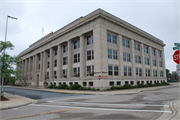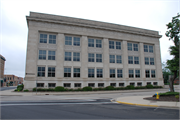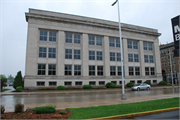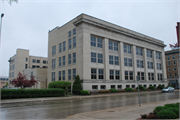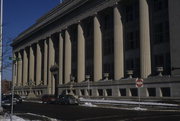| Additional Information: | A 'site file' exists for this property. It contains additional information such as correspondence, newspaper clippings, or historical information. It is a public record and may be viewed in person at the Wisconsin Historical Society, State Historic Preservation Office.
SEE SURVEY FORM.
This office building, encompassing nearly a block was constructed in three phases between 1922 and 1937 as an imposing expression of the Beaux-Arts Classical style. Built of Bedford limestone, a more impressive and costly material than brick, it has a principal facade that is dominated by a three-story colonnade of engaged Doric columns, which support a classical entablature. But what is most striking is the building’s wealth of bas-relief carvings. Between the first and second stories, the spandrels that separate the expansive paired windows display the seals of the states in which the Hardware Mutual Insurance Company did business, and the metal spandrels between the second- and third-floor windows are embossed with a classical asterisk. Greek fretwork ornaments the stone cap along the top of the raised foundation, and griffins and the seals of the United States and Canada adorn the frieze above the colonnade. At the center of the main (east) facade, the ornate molding around the doorway features allegorical figures in niches. Sculptor Ulysses Ricci of New York carved these figures.
Moving through the wrought-iron-and-glass doors (which are doubled in height by a matching transom), the visitor encounters a lavish interior. Like the moldings outside, these finishes are the work of artists from the East Coast. Marble of various colors, quarried in Europe as well as the United States, clads the floors, walls, and stairs. The two walnut-paneled elevators have domed ceilings of polished brass. Painted canvases on the elevator lobby’s ceiling and over the stairs further enrich the interior. These canvases, created by Ethel Parsons Paullin of New York, represent the four seasons, the signs of the zodiac, and the deities of Greek mythology. The wrought-iron chandelier is by Samuel Yellin of Philadelphia, who also designed the lanterns, railings, and doors. Yellin was well known for his work on such important buildings as the National Cathedral in Washington, D.C., and St. Bartholomew's Church in New York City.
Lavish offices are located down the terrazzo-floored north corridor, in the older half of the building. Leaded art glass, designed in the Neo-Tudor style by G. Owen Bonawit of New York City, surrounds the entry to the office suite. In the waiting room, a canvas ceiling depicts a map of North America, painted in a fifteenth-century style by Andrew Schwartz of New York City. On the other side of the building, to the south, the auditorium expresses the modernistic Art Deco style. Here the finishes are extraordinary: the linoleum floor features a geometric pattern; walls are veneered with aspen pine and inlaid with mahogany and cork; the trim is fashioned of aluminum; and aluminum and mahogany grace the proscenium arch. |
|---|

